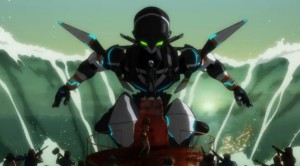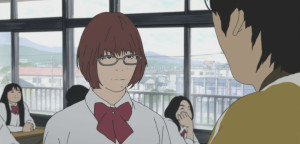Anime Round-Up: April 13, 2013
Flowers of Evil, “A Fateful Encounter” (Episode 1)
Likely to be the most controversial of the new shows in the spring season, Flowers of Evil is based on a manga series of the same name in which an isolated teen, Kasuga, ends up in some sort of blackmail scheme after an even more isolated classmate, Nakamura (at right), spots him grabbing the gym bag of their beautiful peer Sakei. I haven’t read the manga (though I have read a couple of reviews of the first volume — hence my basic understanding of the premise), so this isn’t one of those cases where I know how it’s all going to play out in advance.
However, the first episode is just a damn fine piece of work on its own, regardless of how things play out. The use of rotoscoping — yes, rotoscoping! — is the source of much of the controversy around the series. It departs from the style of manga in a pretty significant and obvious way, and the characters look decidedly unfinished and move in jerky ways that seems to somewhat defeat the point of the attempt at a realistic depiction of the series’s characters.
I call shenanigans on this perspective though. I have no ill will toward rotoscoping, and I find that it adds to the show’s aesthetic in a really delightful way. The town these teens live in is decaying and falling apart. Signs are broken, paint is peeling, plants have either died or growing unchecked in alleys, and rust abounds. It’s animated beautifully in stark contrast to the rotoscoped characters, and their unfinished animated nature feels, to me, to be a part of this degradation that surrounds them. Factor in that these characters are still trying to figure out their own identities and what love means (Kasuga refers to Sakei as both a “muse” and a “femme fatale” — someone who both inspires and destroys), and their rotoscoped “ugliness” feels fitting.
Sonically, the episode’s soundtrack adds to the unsettling nature of the episode with long, low volume tones underlying dialog. It creates, along with the episode’s slow pace, an odd sense of tension that is doesn’t actually feel resolved, unless we count the falling of Sakei’s bag from the shelf as the climax of that tension, and I certainly would. Even if the narrative doesn’t end up delivering anything worthwhile, aesthetically, I there’s a lot to engage with in the show.
After the jump, two mecha series are discussed.
Valvrave the Liberator, “Revolutionary Transfer Student” (Episode 1)
 I have a soft spot for mecha series. So long as its fan service is more about giant robots blowing up shit while being awesome and not about jiggly, over-sized breasts, I can be forgiving about flaws (though not always, see below). Valvrave comes from Sunrise and Ichirō Ōkouchi, who last teamed up for the everything and the kitchen sink anime Code Geass back in 2006. Valvrave has some of Geass‘s elements, including a high school setting, giant robots, and some sort of supernatural element (be sure to watch the whole episode, including after the credits), but grafts on some other mecha tropes, notably space colonies at war with one another.
I have a soft spot for mecha series. So long as its fan service is more about giant robots blowing up shit while being awesome and not about jiggly, over-sized breasts, I can be forgiving about flaws (though not always, see below). Valvrave comes from Sunrise and Ichirō Ōkouchi, who last teamed up for the everything and the kitchen sink anime Code Geass back in 2006. Valvrave has some of Geass‘s elements, including a high school setting, giant robots, and some sort of supernatural element (be sure to watch the whole episode, including after the credits), but grafts on some other mecha tropes, notably space colonies at war with one another.
In this case though, the events start on a neutral space colony/nation of Jior. They’re attacked by the Dorssia Military Pact Federation for what at first seems to be no reason, but it turns out that Jior is has been building themselves a super-advanced mecha in secret (and underneath a high school BECAUSE OF COURSE). The attack results in the apparent death of Shōko, the love interest of Haruto, the show’s non-violent/passive/standard protagonist, and it drives him to take control of the Valvrave mecha after the team of Dorssia psychotic agents, including Haruto’s foil L-elf, fail to properly commandeer it.
What I sort of love about Valvrave is that it not only promises ridiculousness based on the last couple of minutes of the episode, but it’s pretty upfront about the dehumanizing nature of the mecha show in that Haruto has to “resign as a human being” to activate it. Even if the show fails to follow through on this premise — though I don’t see that happening — there should be enough silliness, general violence (the blood is goopy, gushy anime blood, so always a good sign), and mecha action to sustain it beyond any attempts at deeper insight into the mecha genre.
And, well, if you need it, Valvrave has jiggly, over-sized breasts, too. But then so did Code Geass.
Gargantia on the Verdurous Planet, “Castway” (Episode 1)
 Probably the most generic of the three, it’s another mecha series that quickly gets the “It was Earth! All along!” reveal out of the way in the first episode. I only say it’s the most generic because while Valvrave feels very Gundam-y (space colonies, war, ideological conflicts about pacifism and willingness to fight and kill) and as such is firmly in that, it’s at least seems sort of aware that you need that over-the-top “ham and cheese” to at least be entertaining. Gargantia doesn’t really show any of that.
Probably the most generic of the three, it’s another mecha series that quickly gets the “It was Earth! All along!” reveal out of the way in the first episode. I only say it’s the most generic because while Valvrave feels very Gundam-y (space colonies, war, ideological conflicts about pacifism and willingness to fight and kill) and as such is firmly in that, it’s at least seems sort of aware that you need that over-the-top “ham and cheese” to at least be entertaining. Gargantia doesn’t really show any of that.
It starts with a big battle against space versions of lifeforms you’d likely find at those hydrothermal vents at the bottom of the ocean mixed with plants called the Hideauze. Ledo, a long-term solider, doesn’t quite make it back onto his carrier after humanity’s last ditch attack against the creatures fails miserably, and wakes up six months later in some sort of hangar as humans try and open his mecha, Chamber. The humans are decidedly primitive seeming, and Ledo assumes they’re a wandering tribe of non-Alliance members. Turns out he’s actually on a Waterworld-ified Earth, something that’s only a myth to those humans living in space.
I’m still sort of trying to decide how this is going to play out. It’s from Production I.G and Gen Urobuchi. The former is a great studio, and the latter has worked on Psycho-Pass and Puella Magi Madoka Magica, neither of which I’ve seen but have heard if not positive, then decidedly partisan things about; that is better than being terrible or just outright boring. It also hopefully means that Gargantia will become more interesting than a fish out of water mecha pilot whose love interest will likely end up being Amy, the Earthling with a flying squirrel for a pet.
I’m also catching up on Blast of Tempest (finally) and am also watching Chihayafuru 2, which is just as charming and delightful as its first season so far. I don’t know that I’d recommend Tempest (it’s so anime), but I really encourage everyone to watch Chihayafuru.
You can stream all the shows I’m watching on Crunchyroll.


